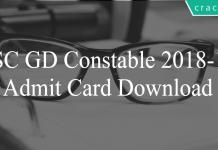Trigonometry Questions for SSC MTS 2022
Here you can download the Trigonometry Questions for SSC MTS PDF with solutions by Cracku. These are the most important Politics questions PDF prepared by various sources also based on previous year’s papers. Utilize this PDF for Trigonometry for SSC MTS preparation. You can find a list of the most important Trigonometry questions in this PDF which help you to test yourself and practice. So you can click on the below link to download the PDF for reference and do more practice.
Download Trigonometry Questions for SSC MTS
Enroll to 15 SSC MTS 2022 Mocks At Just Rs. 149
Question 1: If $\cot \theta = \frac{15}{8}, \theta$ is an acute angle, then find the value of $\frac{(1 – \cos \theta)(2 + 2 \cos \theta)}{(2 – 2 \sin \theta)(1 + \sin \theta)}$.
a) $\frac{225}{64}$
b) $\frac{64}{225}$
c) $\frac{16}{15}$
d) $\frac{8}{15}$
1) Answer (B)
Solution:
$\cot\theta=\frac{15}{8}$
$\tan\theta=\frac{8}{15}$
$\sec\theta=\sqrt{1+\tan^2\theta\ }=\sqrt{1+\left(\frac{8}{15}\right)^2}=\sqrt{\frac{289}{225}\ }=\frac{17}{15}$
$\cos\theta=\frac{15}{17}$
$\sin\theta=\sqrt{1-\cos^2\theta\ }=\sqrt{1-\left(\frac{15}{17}\right)^2}=\sqrt{1-\frac{225}{289}}=\sqrt{\frac{64}{289}}=\frac{8}{17}$
$\frac{(1-\cos\theta)(2+2\cos\theta)}{(2-2\sin\theta)(1+\sin\theta)}=\frac{\left(1-\frac{15}{17}\right)\left[2+2\left(\frac{15}{17}\right)\right]}{\left[2-2\left(\frac{8}{17}\right)\right]\left(1+\frac{8}{17}\right)}$
$=\frac{\left(\frac{2}{17}\right)\left[\frac{64}{17}\right]}{\left[\frac{18}{17}\right]\left(\frac{25}{17}\right)}$
$=\frac{2\times64}{18\times25}$
$=\frac{64}{225}$
Hence, the correct answer is Option B
Question 2: If $2 \cos^2 \theta – 5 \cos \theta + 2 = 0, 0^\circ < \theta < 90^\circ$, then the value of $(\sec \theta + \tan \theta)$ is:
a) $2 + \sqrt{3}$
b) $1 – \sqrt{3}$
c) $1 + \sqrt{3}$
d) $2 – \sqrt{3}$
2) Answer (A)
Solution:
$2\cos^2\theta-5\cos\theta+2=0$
$2\cos^2\theta-4\cos\theta-\cos\theta+2=0$
$2\cos\theta\left(\cos\theta-2\right)-1\left(\cos\theta-2\right)=0$
$\left(\cos\theta-2\right)\left(2\cos\theta-1\right)=0$
$\cos\theta=2$ or $\cos\theta=\frac{1}{2}$
$\cos\theta=2$ is not possible.
So, $\cos\theta=\frac{1}{2}$
$\sec\theta=2$
$\tan\theta=\sqrt{\sec^2\theta-1}=\sqrt{4-1}=\sqrt{3}$
$\therefore$ $\left(\sec\theta+\tan\theta\right)=2+\sqrt{3}$
Hence, the correct answer is Option A
Question 3: Find the value of $\tan35^{\circ}\cot40^{\circ}\tan45^{\circ}\cot50^{\circ}\tan55^{\circ}$.
a) $\frac{1}{\sqrt{2}}$
b) $\frac{1}{2}$
c) -1
d) 1
3) Answer (D)
Solution:
$\tan35^{\circ}\cot40^{\circ}\tan45^{\circ}\cot50^{\circ}\tan55^{\circ}=\tan35^{\circ}\cot40^{\circ}\tan45^{\circ}\cot\left(90-40^{\circ}\right)\tan\left(90-35^{\circ}\right)$
$=\tan35^{\circ}\cot40^{\circ}\left(1\right)\tan40^{\circ}\cot35^{\circ}$
$=1$
Hence, the correct answer is Option D
Question 4: If $\sin(20 + x)^\circ = \cos 60^\circ, 0 \leq (20 + x) \leq 90$, then find the value of $2 \sin^2(3x + 15)^\circ – \cosec^2(2x + 10)^\circ$.
a) 3
b) -3
c) $-\frac{1}{3}$
d) -2
4) Answer (B)
Solution:
$\sin(20+x)^{\circ}=\cos60^{\circ}$
$\sin(20+x)^{\circ}=\sin30^{\circ}$
$20+x=30$
$x=10$
$2\sin^2(3x+15)^{\circ}-\operatorname{cosec}^2(2x+10)^{\circ}=2\sin^245^{\circ}-\operatorname{cosec}^230^{\circ}$
$=2\left(\frac{1}{\sqrt{2}}\right)^2-\left(2\right)^2$
$=2\left(\frac{1}{2}\right)-4$
$=1-4$
$=-3$
Hence, the correct answer is Option B
Question 5: If $\sin^6 \theta + \cos^6 \theta = \frac{1}{3}, 0^\circ < \theta < 90^\circ$, then what is the value of $\sin \theta \cos \theta$?
a) $\frac{\sqrt{2}}{3}$
b) $\frac{\sqrt{6}}{6}$
c) $\frac{\sqrt{2}}{\sqrt{3}}$
d) $\frac{2}{9}$
5) Answer (A)
Solution:
$\sin^6\theta+\cos^6\theta=\frac{1}{3}$
$\left(\sin^2\theta\right)^3+\left(\cos^2\theta\right)^3=\frac{1}{3}$
$\left(\sin^2\theta+\cos^2\theta\right)\left(\sin^4\theta-\sin^2\theta\ \cos^2\theta+\cos^4\theta\ \right)=\frac{1}{3}$
$\left(1\right)\left(\sin^4\theta+\cos^4\theta+2\sin^2\theta\ \cos^2\theta-3\sin^2\theta\ \cos^2\theta\ \right)=\frac{1}{3}$
$\left(\sin^2\theta+\cos^2\theta\right)^2-3\sin^2\theta\ \cos^2\theta\ =\frac{1}{3}$
$1-3\sin^2\theta\ \cos^2\theta\ =\frac{1}{3}$
$3\sin^2\theta\ \cos^2\theta\ =\frac{2}{3}$
$\sin^2\theta\ \cos^2\theta\ =\frac{2}{9}$
$\sin\theta\ \cos\theta=\frac{\sqrt{2}}{3}$
Hence, the correct answer is Option A
Take a free SSC MTS Tier-1 mock test
Download SSC CGL Tier-1 Previous Papers PDF
Question 6: If $\sin(\theta+30^{\circ})=\frac{3}{\sqrt{12}}$, then the value of $\theta$ is equal to:
a) $15^\circ$
b) $60^\circ$
c) $30^\circ$
d) $45^\circ$
6) Answer (C)
Solution:
Given, $\sin(\theta+30^{\circ})=\frac{3}{\sqrt{12}}$
$\Rightarrow$ $\sin(\theta+30^{\circ})=\frac{3}{2\sqrt{3}}$
$\Rightarrow$ $\sin(\theta+30^{\circ})=\frac{\sqrt{3}\times\sqrt{3}}{2\sqrt{3}}$
$\Rightarrow$ $\sin(\theta+30^{\circ})=\frac{\sqrt{3}}{2}$
$\Rightarrow$ $\sin(\theta+30^{\circ})=\sin60^{\circ\ }$
$\Rightarrow$ $\theta+30^{\circ}=60^{\circ\ }$
$\Rightarrow$ $\theta=30^{\circ\ }$
Hence, the correct answer is Option C
Question 7: If $\frac{\sec\theta+\tan\theta}{\sec\theta-\tan\theta}=5$ and $\theta$ is an acute angle, then the value of $\frac{3\cos^2\theta+1}{3\cos^2\theta-1}$ is:
a) 4
b) 3
c) 1
d) 2
7) Answer (A)
Solution:
Given, $\frac{\sec\theta+\tan\theta}{\sec\theta-\tan\theta}=5$
$\Rightarrow$ $\sec\theta+\tan\theta=5\sec\theta\ -5\tan\theta\ $
$\Rightarrow$ $6\tan\theta=4\sec\theta$
$\Rightarrow$ $6\frac{\sin\theta\ }{\cos\theta\ }=4\frac{1}{\cos\theta\ }$
$\Rightarrow$ $\sin\theta=\frac{2}{3}$
$\cos^2\theta\ =1-\sin^2\theta\ =1-\left(\frac{2}{3}\right)^2=\frac{5}{9}$
$\therefore\ $ $\frac{3\cos^2\theta+1}{3\cos^2\theta-1}=\frac{3\left(\frac{5}{9}\right)+1}{3\left(\frac{5}{9}\right)-1}$
$=\frac{\frac{5}{3}+1}{\frac{5}{3}-1}$
$=\frac{8}{2}$
$=4$
Hence, the correct answer is Option A
Question 8: If sin(A – B) = $\frac{1}{2}$ and cos(A + B) = $\frac{1}{2}$ where A > B > 0$^\circ$ and A + B is an acute angle, then the value of A is:
a) $30^\circ$
b) $60^\circ$
c) $45^\circ$
d) $15^\circ$
8) Answer (C)
Solution:
Given, sin(A – B) = $\frac{1}{2}$
$\Rightarrow$ sin(A – B) = sin 30$^{\circ\ }$
$\Rightarrow$ A – B = 30$^{\circ\ }$ ……..(1)
cos(A + B) = $\frac{1}{2}$ and A + B is an acute angle
$\Rightarrow$ cos(A + B) = cos 60$^{\circ\ }$
$\Rightarrow$ A + B = 60$^{\circ\ }$ ……..(2)
Adding equations (1) and (2),
2A = 90$^{\circ\ }$
$\Rightarrow$ A = 45$^{\circ\ }$
Hence, the correct answer is Option C
Question 9: If $2x=\sin\theta$ and $\frac{2}{x}=\cos\theta$, then the value of $4\left(x^2+\frac{1}{x^2}\right)$ is:
a) 1
b) 0
c) 2
d) 4
9) Answer (A)
Solution:
Given, $2x=\sin\theta$ and $\frac{2}{x}=\cos\theta$
From the trigonometric identities,
$\sin^2\theta\ +\cos^2\theta\ =1$
$\Rightarrow$ $\left(2x\right)^2+\left(\frac{2}{x}\right)^2=1$
$\Rightarrow$ $4x^2+\frac{4}{x^2}=1$
$\Rightarrow$ $4\left(x^2+\frac{1}{x^2}\right)=1$
Hence, the correct answer is Option A
Question 10: If X = $\tan 40^\circ$, then the value of $2 \tan 50^\circ$ will be:
a) $\frac{2}{X}$
b) 2X
c) $\frac{1}{X}$
d) $\frac{1}{2X}$
10) Answer (A)
Solution:
Given, X = $\tan 40^\circ$
$\therefore\ 2\tan50^{\circ}=2\tan\left(90-40^{\circ}\right)$
$=2\cot40^{\circ}$
$=\frac{2}{\tan40^{\circ\ }}$
$=\frac{2}{X\ }$
Hence, the correct answer is Option A
Question 11: If $2\cot\theta=3$, then $\frac{\sqrt{13}\cos\theta-3\tan\theta}{3\tan\theta+\sqrt{13}\sin\theta}$ is:
a) $\frac{3}{4}$
b) $\frac{1}{4}$
c) $\frac{2}{3}$
d) $\frac{1}{5}$
11) Answer (B)
Solution:
Given, $2\cot\theta=3$
$\Rightarrow$ $\cot\theta=\frac{3}{2}$
$\tan\theta=\frac{2}{3}$
$\operatorname{cosec}\theta\ =\sqrt{1+\cot^2\theta\ }=\sqrt{1+\left(\frac{3}{2}\right)2}=\sqrt{1+\frac{9}{4}}=\sqrt{\frac{13}{4}}=\frac{\sqrt{13}}{2}$
$\sin\theta\ =\frac{2}{\sqrt{13}}$
$\cos\theta\ =\sqrt{1-\sin^2\theta\ }=\sqrt{1-\frac{4}{13}}=\sqrt{1-\left(\frac{2}{\sqrt{13}}\right)^2}=\sqrt{\frac{9}{13}}=\frac{3}{\sqrt{13}}$
$\therefore\ $ $\frac{\sqrt{13}\cos\theta-3\tan\theta}{3\tan\theta+\sqrt{13}\sin\theta}=\frac{\sqrt{13}\left(\frac{3}{\sqrt{13}}\right)-3\left(\frac{2}{3}\right)}{3\left(\frac{2}{3}\right)+\sqrt{13}\left(\frac{2}{\sqrt{13}}\right)}$
$=\frac{3-2}{2+2}$
$=\frac{1}{4}$
Hence, the correct answer is Option B
Question 12: If $x\sin^3\theta+y\cos^3\theta=\sin\theta\cos\theta$ and $x\sin\theta=y\cos\theta$, then the value of $x^2 + y^2$ is:
a) 4
b) 0
c) 2
d) 1
12) Answer (D)
Solution:
Given, $x\sin\theta=y\cos\theta$
$\Rightarrow$ $y=\frac{x\sin\theta}{\cos\theta\ }$
$x\sin^3\theta+y\cos^3\theta=\sin\theta\cos\theta$
$\Rightarrow$ $x\sin^3\theta+\frac{x\sin\theta\ }{\cos\theta\ }\cos^3\theta=\sin\theta\cos\theta$
$\Rightarrow$ $x\sin^3\theta+x\sin\theta\ \cos^2\theta=\sin\theta\cos\theta$
$\Rightarrow$ $x\sin\theta\ \left(\sin^2\theta+\cos^2\theta\right)=\sin\theta\cos\theta$
$\Rightarrow$ $x\sin\theta\ =\sin\theta\cos\theta$
$\Rightarrow$ $x=\cos\theta$
$\therefore\ $ $y=\frac{x\sin\theta}{\cos\theta\ }=\frac{\cos\theta\ \sin\theta}{\cos\theta\ }$
$\Rightarrow$ $y=\sin\theta\ $
$\therefore\ $ $x^2+y^2=\cos^2\theta\ +\sin^2\theta=1\ $
Hence, the correct answer is Option D
Question 13: If $\sqrt{3}\cos\theta=\sin\theta$, then the value of $\frac{4\sin^2\theta-5\cos\theta}{3\cos\theta+1}$ is:
a) $\frac{1}{4}$
b) $\frac{1}{5}$
c) 5
d) $\frac{2}{5}$
13) Answer (B)
Solution:
Given, $\sqrt{3}\cos\theta=\sin\theta$
$\Rightarrow$ $\sqrt{3}=\frac{\sin\theta}{\cos\theta\ }$
$\Rightarrow$ $\tan\theta\ =\sqrt{3}$
$\Rightarrow$ $\tan\theta\ =\tan60^{\circ\ }$
$\Rightarrow$ $\theta =60^{\circ\ }$
$\therefore\ $ $\frac{4\sin^2\theta-5\cos\theta}{3\cos\theta+1}=\frac{4\sin^260^{\circ\ }-5\cos60^{\circ\ }}{3\cos60^{\circ}+1}$
$=\frac{4\left(\frac{\sqrt{3}}{2}\right)^2-5\left(\frac{1}{2}\right)}{3\left(\frac{1}{2}\right)+1}$
$=\frac{4\left(\frac{3}{4}\right)-\frac{5}{2}}{\frac{3}{2}+1}$
$=\frac{3-\frac{5}{2}}{\frac{5}{2}}$
$=\frac{\frac{1}{2}}{\frac{5}{2}}$
$=\frac{1}{5}$
Hence, the correct answer is Option B
Question 14: If $\cos3\theta=\sin(\theta-34^{\circ})$, then the value of $\theta$ as an acute angle is:
a) $56^\circ$
b) $17^\circ$
c) $31^\circ$
d) $34^\circ$
14) Answer (C)
Solution:
Given, $\cos3\theta=\sin(\theta-34^{\circ})$
$\Rightarrow$ $\cos3\theta=\cos\left[90-(\theta-34^{\circ})\right]$
$\Rightarrow$ $\cos3\theta=\cos\left[90-\theta+34^{\circ}\right]$
$\Rightarrow$ $\cos3\theta=\cos\left[124^{^{\circ}}-\theta\right]$
$\Rightarrow$ $3\theta=124^{^{\circ}}-\theta$
$\Rightarrow$ $4\theta=124^{^{\circ}}$
$\Rightarrow$ $\theta=31^{^{\circ}}$
Hence, the correct answer is Option C
Question 15: The value of $\sin60^{\circ}\cos30^{\circ}-\cos60^{\circ}\sin30^{\circ}$ is:
a) 1
b) $\frac{1}{2}$
c) $\frac{\sqrt 3}{2}$
d) $\frac{1}{\sqrt 2}$
15) Answer (B)
Solution:
$\sin60^{\circ}\cos30^{\circ}-\cos60^{\circ}\sin30^{\circ}=\frac{\sqrt{3}}{2}\times\frac{\sqrt{3}}{2}-\frac{1}{2}\times\frac{1}{2}$
$=\frac{3}{4}-\frac{1}{4}$
$=\frac{2}{4}$
$=\frac{1}{2}$
Hence, the correct answer is Option B





